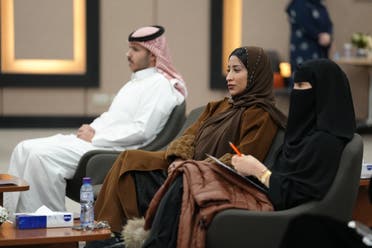The founder’s library discusses the stories of Saudi traditional costumes

Dr. Laila Al-Bassam, Professor of Traditional Costumes and Textiles at Princess Noura Bint Abdul Rahman University, reviewed collections of traditional Saudi costumes, by presenting their designs, and methods of decoration and embroidery in various regions of Saudi Arabia.
She explained that these methods are distinguished according to the heritage of the tribes that inhabit each region, and depending on the atmosphere and weather conditions, as well as the quality of raw materials in each region, and that there are traditional costumes that have disappeared, and others that still exist that emphasize the depth of communication between generations in the field of fashion.
This came during a symposium held by the King Abdulaziz Public Library in Riyadh as part of its cultural season for the year 2023, entitled: “Tales told by Saudi traditional costumes,” on Wednesday evening, January 11, at the Services Branch and Reading Halls in Riyadh, in partnership with the Royal Institute of Traditional Arts, and it was moderated by fashion and textile designer Manahil Al Qasim. .
The topics of the symposium revolved around: the distinction of traditional Saudi traditional costumes with the ancient and diverse cultural heritage in the regions of the Kingdom, the association of the colors of Saudi costumes with the climate and terrain of the social life of each region, and the sustainability of the craft of making traditional Saudi costume and its development without prejudice to the spirit of heritage.
Dr. Laila Al-Bassam
ancient heritage
Dr. has shed. Laila Al-Bassam, shed light on the ancient heritage of folk costumes in the Kingdom, and saw that she continues to give, and use these costumes to inspire modern, sophisticated fashion that indicates communication between generations, and has an artistic and heritage dimension that connects us to the heritage of our ancestors.
Al-Bassam said: The Kingdom is wide and multi-regional, and traditional costumes can be divided into four forms: women’s and men’s fashion, women’s-only fashion, and men’s-only fashion.
Among the most prominent of these costumes is (draaa) and (mouroudan), and we see it in the clothes of the ardh, the daqla, the zubun, and the sayah. Al-Mubdah, Al-Mufhah, and Al-Mufrah. It is rectangular in shape and consists of three colors: red, yellow, and green. There are luxurious types of this garment with embroidery on the front and back.

from attendance
Daraa
As for the (draaa), it consists of the long sleeve, the body, and the bunika, and its embroidery differs from one region to another. For women and men, and Marwad is widespread in the northern region, and often the black color comes to women, and white to men.
Dr. Laila Al-Bassam added: The cloud dress represents an innovative method in designing the dress and has a tail, and it is located in the Najd region. For girls, (the hat) and (al-Qarqosh), and showed that lead beads were used in the decoration of headdresses, especially in the western region, and in the decoration of women’s clothing, between the Salim and Harb tribes, and this was transferred to the new costumes.
burqas
And there is (the burqa), which is embroidered with coins, which they mince and attach to the burqa, and there is (marisha) in the southern region, and wicker hats, which are called (tafashat). Belt block, rings of coral in a band tied on the head.
Al-Bassam touched on the famous head coverings in Saudi fashion, such as: the shemagh, the turban, the ghutra, and the headband, and they were imported from Switzerland, Britain, Kashmir, and India, and the braided headband was the most famous in the Kingdom and the Arab Gulf countries, and the kings of the kingdom and the sheikhs of the Gulf always wore it, It also touched on other types of thobes, including: al-Muhawthil, al-Muqabqar and al-Junab, and the waistcoat, and all of these types show accuracy, mastery, added texture, and the multiplicity of traditional ornamentation and embroidery, which indicates the richness, diversity, and renewal of the fashion heritage in the Kingdom.
xnxx,
xvideos,
porn,
porn,
xnxx,
Phim sex,
mp3 download,
sex 4K,
Straka Pga,
gay teen porn,
Hentai haven,
free Hentai,
xnxx,
xvideos,
porn,
porn,
xnxx,
Phim sex,
mp3 download,
sex 4K,
Straka Pga,
gay teen porn,
Hentai haven,
free Hentai,


